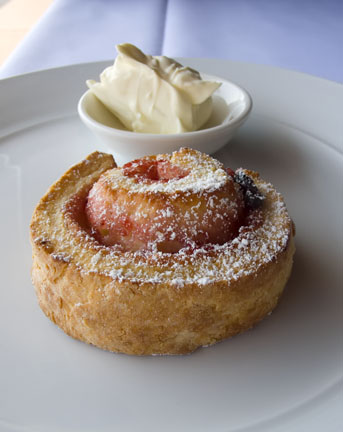Strawberry Seduction : Strawberry Jam Snails with clotted cream
Mike’s Table is celebrating a season of sensational strawberries, and I’m reminded of the time I had a glut of strawberries leftover from a function. They were absolutely gorgeous fruit – punnets of them, stored in our large coolroom. They filled the space with the intoxicating smell of pure strawberry. I immediately thought of making jam, to capture them at their peak. There was no other upcoming event that required the use of strawberries, so they would eventually have been eaten by staff or binned anyway. That’s the thing about working with functions sometimes, and as a result, I’ve been slowly accumulating an eclectic collection of jams in my section : pineapple and star anise, raspberry and eau de vie, banana and honey (quite a good one, by Jane and Jeremy Strode), and my favourite, strawberry and vanilla jam. The recipe is by Christine Ferber from her book, Mes Confitures. A great way to use the resulting jam, apart from spreading it on toast, is to make it into strawberry butter, which features in Belinda Jeffery’s fantastic Strawberry Jam ‘Snails’ recipe. These scrolled scone-like treats are so great I have to stop myself after one, or there would be no looking back! (Incidentally, for those with less of a sweet tooth, I can vouch for the fact that adapting the recipe to make a savoury Roquefort and Hazelnut version is also a very good treat in itself.)
Strawberry Jam ‘Snails’ :
(makes 10; from Mix & Bake by Belinda Jeffery)
300g self-raising flour
pinch salt
1 tablespoon castor sugar
75g cold unsalted butter, cut into small chunks
180-250ml milk
1 egg yolk, whisked with 2 teaspoons of water or milk (optional)
icing sugar, for dusting
more jam, copious amounts of double thick cream and fresh strawberries (optional), to serve [Belinda says she tends to gild the lily with this particular tea time treat. I’ve one-upped Belinda by serving mine with clotted cream from the Yarra Valley]
Strawberry butter:
60g unsalted butter, at room temperature
80g homemade strawberry jam
Preheat oven to 200’C.
Place the flour, salt and sugar in a bowl. Rub the butter chunks into the flour mixture. Pour in the milk and mix it in lightly with a fork; you will have to adjust the milk a little – you need just enough to make a soft, slightly flaky dough.
Turn the dough out onto a floured chopping board and knead it gently until it’s fairly smooth. Roll the dough (or pat it out with your hands) into a rectangle about 30cm x 20cm.
For the strawberry butter, put the butter and jam into the food processor and whiz them together until they’re thoroughly mixed. Spread the strawberry butter evenly over the dough. Starting at the long side nearest you, roll the dough up like a jam roll. Use a lightly floured knife to cut the roll into 3cm-thick slices.
Sit the scones, cut side-down, on a baking tray lined with baking paper, leaving a gap between each one to allow them to spread. (If you have the time you can refrigerate the scones at this stage for 1 hour or so before baking them – they seem to hold together better if you do).
Just before putting the scones in the oven, brush around the sides of each one with the egg yolk mixture, if using, to give them a golden glaze. Bake for 15-20 minutes or until the scones are light golden. Take the scones out of the oven, dust them with icing sugar and pop them into a serving basket lined with a clean cloth or tea towel to keep them warm.
Serve them straightaway with jam, cream and fresh strawberries.






